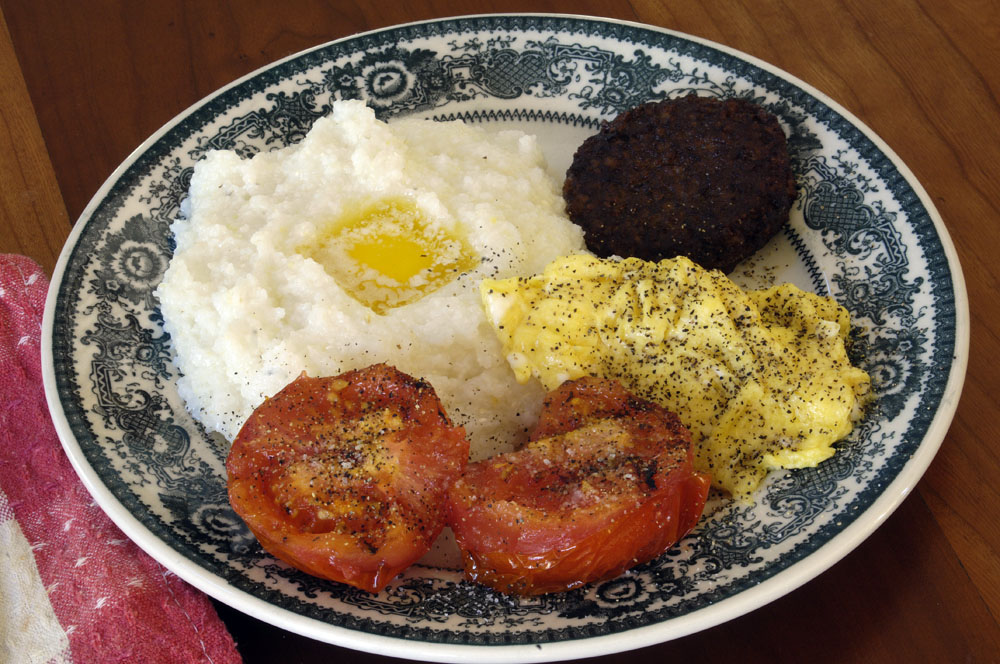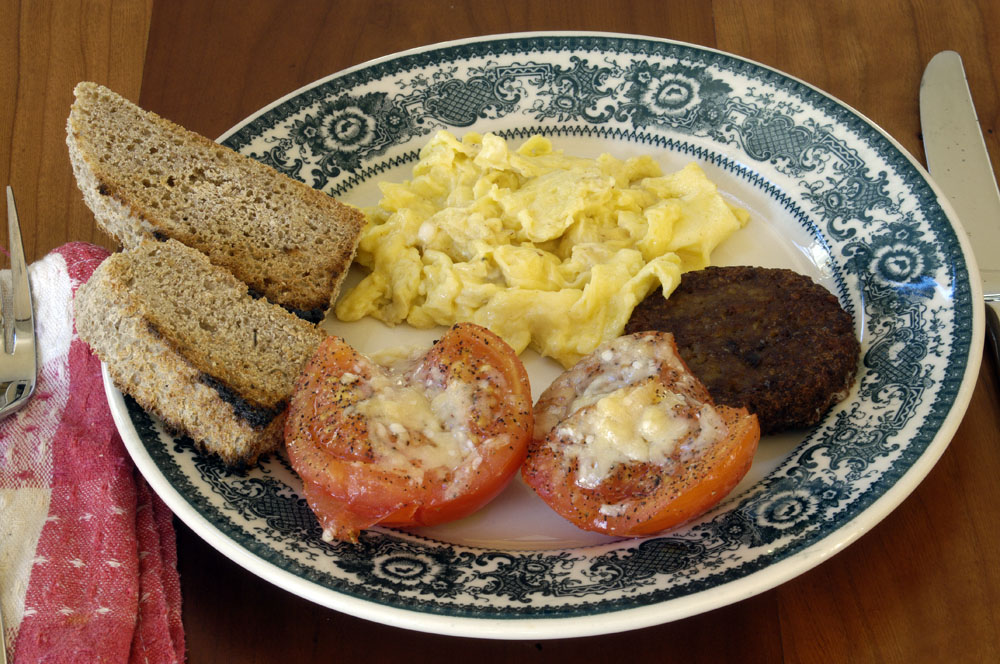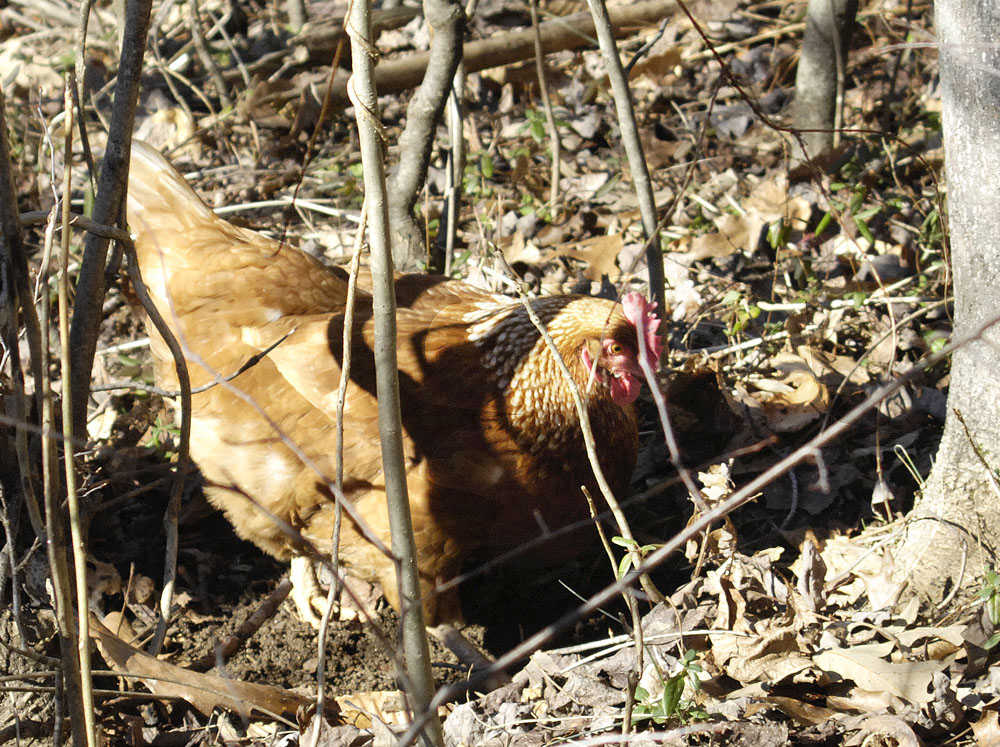And remember, anything MacDonald’s can do, you can do better. And cheaper. And not have to eat off of paper.
This is a homemade sausage biscuit with Morning Star vegetarian sausage.
Watching a bewildering world from the middle of nowhere
Probably many of the people who eat at Jim’s Grill in Yadkinville remember when it was a hot spot in the 1950s — curb service, window trays, juke box, the works. It’s on U.S. 601, which runs north to south across most of North and South Carolina and which used to be part of a major route from points north to Florida.
I’ve had a sentimental weakness for roadside eateries for as long as I can remember. Some of them still remain along the old secondary roads. The sad thing, though, is that every time I’m in Jim’s Grill (I make pretty regular trips to Yadkin County), I never see any young people there. Younger people, I suppose, are sentimental about MacDonald’s rather than the old roadside restaurants.
One of the great things about old-fashioned fast food is that there is no waste paper, cardboard, or plastic to throw away. It’s a pity, though, that (as far as I know) they’re all using plastic dinnerware rather than the heavy diner china that they used to use.
I love the taste of organic stone-ground whole-wheat. It tastes like wheat, and I love wheat. I also make no apologies to anti-gluten partisans, because I think that good wheat breads baked at home from good organic flour are not at all the same thing as commercial baked goods. I’ll leave it as an exercise for the reader to Google for the difference between stone-ground flour and ordinary whole-wheat flour and how they are milled. But there is an easily detectable difference in taste. Ordinary whole-wheat flour often has a bitterness, or what country folks disdain as having a “whang” about it. Stone-ground whole wheat flour has no whang. It tastes like honest wheat, which is what it is.
But the problem with stone-ground whole-wheat flour is that it is very hard to work with. The bran is rough and dry. Unless you use baking techniques optimized for stone-ground flour, your baked items are likely to end up hard and dry. The easy and fast method is to combine the stone-ground flour with whatever portion of unbleached flour your conscience will permit.
Artisan bakers of yeast and sourdough breads who work with stone-ground flour insist on soaking the flour before using it. That softens the bran, encourages some beneficial chemical processes, and makes a tastier, better-rising bread. You also need to get as much moisture into the bread as possible. Surely, I thought, the same concepts can be applied to quick-breads like biscuits.
As usual, I apologize for not usually giving specific recipes here. Part of the reason is that I rarely use exact recipes for things that I make frequently. Another reason is that this is about a concept — the concept of making quick-bread with stone-ground flour. I’m assuming that you’re already an experienced biscuit-maker and that you already have a method or a recipe.
The night before you make the biscuits, mix your stone-ground whole-wheat flour with milk (or buttermilk). We’re going to add more liquid in the morning, so use only enough milk to satisfy the thirst of the flour while keeping the mixture fairly stiff. Also add a teaspoon to a tablespoon of apple cider vinegar, depending on how large a batch of biscuits you’re making. Put this in the refrigerator, covered, overnight.
The usual method of mixing biscuits completely falls apart if you’re starting with wet flour. I suppose you could mix your shortening into the flour before the soak, but I don’t. Take your flour mixture out of the refrigerator early to let it come to room temperature. Cut your shortening into small pieces (I use butter) and use your hand to mix the shortening into the flour mixture. This will take some patience, but small lumps are OK.
Now the objective is to get a bit more liquid mixed into the dough, along with the salt and baking powder. Cutting the dough into pieces (leave it in the bowl) might help here. Add the baking powder and salt. Add more buttermilk if you used buttermilk, or heavy cream if you used milk the night before. The thickness of the buttermilk or cream helps get more moisture into the dough. You should end up with a moist biscuit dough. Shape the dough into biscuits as you usually would.
I bake the biscuits at 450 degrees using the bread function of the Cuisinart oven, which injects steam into the oven for the first seven minutes of baking. This helps keep moisture in the biscuits and improves oven spring. If you don’t have a steam oven, flinging a little water into the oven or having a shallow pan of water in the oven during pre-heating can’t hurt.
Biscuits made this way are some of the tastiest, most tender biscuits I’ve ever made, no lie.
By the way: Over the years, when I’ve discussed biscuit-making with inexperienced or casual bakers, I’m surprised how many people are completely unclear on the concept of what “self-rising” flour is. Some people think that there is something magical or special about self-rising flour and that it’s the only kind of flour from which biscuits can be made. But self-rising flour is just flour to which leavening agents such as soda and baking powder already have been added. Any biscuit recipe that starts with “plain” flour will tell you how much soda or baking powder to use per cup of flour. King Arthur makes an unbleached self-rising flour, but I have never used that, or any, self-rising flour. Self-rising flour seems like a useless convenience, as far as I’m concerned, especially since I use potassium-based, no-sodium baking powder like the baking powder sold by Hain.
I had not made ice cream in well over a year. But the chickens have been laying well lately, so I start thinking about how to spend some eggs. Ice cream was a start. If you want to make ice cream, you have to crack some eggs. Proper ice cream has egg yolks in it.
Here’s a basic recipe for vanilla ice cream with a whiff of lemon. You could add whatever you like to this recipe to make different flavors.
Rich, old-fashioned ice cream
4 egg yolks 1/2 cup sugar 1 cup whipping cream 1 cup milk 2 teaspoons vanilla extract 1/4 teaspoon lemon extract
In a double-boiler, whisk everything together except for the extracts. While whisking over steam, heat the mixture to about 175 degrees. Then pour the mixture into an ovenproof glass bowl, cover it, and chill it to refrigerator temperature. This will take several hours, or overnight.
When you’re ready to make the ice cream, add the extracts (or other flavorings) and pour the mixture into your ice cream freezer.
I don’t waste the egg whites. When I have leftover egg whites, if I can’t think of anything else to do with them, then I cook them and feed them back to the chickens. Chickens certainly should not eat chicken, but eggs are good for them if you cook the eggs and mix them with other scraps so that the chickens don’t know what it is.
As long as you’re making grits, make too much. Bring the leftovers back the next day as fried grits.
Grits and polenta are notoriously hard to brown. But if you shape the grits into patties before they cool, wrap the patties in a paper towel to help remove excess moisture, and put them in the refrigerator until the next day, they’ll brown reasonably well.
As long as you’re firing up the grill to roast a winter tomato, why not grill everything but the egg? The grits above were grilled, as was the fake Morningstar sausage.
It’s actually kind of nice being out on the deck in January weather, cooking over a hot grill. It’s particularly nice to have a breakfast with a campfire flavor.

The tomatoes above were grilled on a gas grill. The sausage is Morning Star fake sausage.
Those winter tomatoes almost look real in the grocery store, don’t they? Then you get them home, and they’re tasteless and mealy. They’re barely fit for salads. I know of only one way to get some taste into them — grill them.
Yesterday I broiled the tomatoes in the oven, with some parmesan. This morning I grilled them, with nothing but salt and pepper. The grilled tomatoes, by far, were tastier. Luckily, the grill is on the deck just outside the kitchen door, so getting to the grill is convenient for small jobs like grilling tomatoes for breakfast.
It’s sad to see the eggs go pale in winter. It’s the grass and green things the chickens eat that make the yolks so deeply colored. It’s not that there isn’t some grass in the orchard in the winter. Rather, it’s that the turf is very vulnerable to damage in the winter if the chickens scratch too much. So in the winter the chickens stay mostly in the bare garden, where they can do no harm. Getting orchard time is a treat for the chickens during fine winter weather.
About those grits. I feel like a salesman because I’m always promoting the Cuisinart CSO-300 steam oven. But it’s the best way of cooking grits I’ve ever seen, by far. Just put the grits in an uncovered ovenproof bowl, 3 parts water to 1 part grits. Cook them on “super steam” at 300 degrees for 30 minutes. Then let the grits sit, covered, for about 10 minutes before serving. The grits come out perfectly cooked without any need for stirring and dealing with grit splatter.

These tomatoes were broiled in the oven, with parmesan
One food that is not pale in January: the New Year collards. December was warm and wet, perfect for collards. I got these collards at a local grocery store. They were grown in South Carolina.
It has been nice to see a number of stories in the past month about major restaurant chains switching to cage-free eggs. But it’s a slow process. There’s an awful lot of industrial chicken infrastructure that has to be changed. And even hens that aren’t in cages are not exactly living in chicken heaven. The majority of cage-free hens will still be packed into big, crowded barns with no access to the outdoors.
Wendy’s restaurants announced yesterday that they will go cage-free by 2020. Starbucks and Panera also have promised to go cage-free by 2020. McDonald’s and Subway will take 10 years to go cage-free — 2025.
This is a start. Surely it was the market, or “consumer sentiment,” that demanded this change. People are becoming increasingly aware of our cruelty to animals kept on industrial farms. However, I suspect that, for psychological reasons, most people have less denial in thinking about chickens raised for eggs, because laying hens aren’t slaughtered (not, at least, when they’re still young). It’s easier to think about the lives of laying hens than about the short lives of broiler chickens.
Here’s a link to a nice Chicago Tribune story on cage-free egg farming. A farmer is quoted as saying that he keeps his hens for over seven years before they’re sent off to be made into soup. I’m a bit skeptical that hens are kept that long.
Though I love knowing that all my eggs are laid just up the hill, I’m very aware that having chickens is not for everybody. If I were buying eggs, I’d just pay extra for the most hen-friendly eggs I could find.

Given a choice on a January day between a grassy orchard and the woods, the girls prefer the woods, though they also spend time in the orchard to get the clover and chickweed.
There is no way to make pancakes into a truly healthy breakfast. But, sooner or later, we’re all going to give in to the temptation of eating them. I’m always looking for ways to make eating comfort foods more of a misdemeanor rather than a felony.
To be sure, it has been decades since I’ve eaten a pancake made of white flour. Yuck. My flour of choice at present is sprouted whole wheat flour. But it’s still just flour. How might we get the carb load down and the fiber and nutrition load up?
I’ve often used cooked apples as a topping for pancakes, but how might we do that with raw apples? This morning I grated two Granny Smith apples (the KitchenAid shredder made quick and easy work of it). I tossed the apples in maple syrup with some cinnamon.
That meant one pancake for breakfast instead of two, plus two fewer apples waiting in the refrigerator for me to figure out what to do with them. The apples were yummy prepared that way. There are worse crimes.
A common supper at the abbey is pasta and vegetables. The default pasta sauce probably (I’m ashamed to say) is parmesan and cream. But variety is nice, and parmesan and cream make a pretty heavy sauce.
I’m still working on refining this recipe, but here’s a working version with some ideas for improvement.
Toasted sesame sauce
2 tablespoons sugar 2 tablespoons rice vinegar 2 tablespoons toasted sesame oil 1 tablespoon soy sauce 1 teaspoon pepper sauce (such as harissa sauce) 4 cloves of garlic 1 to 2 tablespoons peanut butter
Combine the sugar and vinegar in a small skillet. Simmer it until it starts to thicken. Pour it into a small bowl and set it aside.
Sautée the garlic lightly in the sesame oil. Add the soy sauce and harissa sauce and let it simmer for a few minutes.
Add the peanut butter to the vinegar mixture. Stir it until it thickens.
Add the peanut butter and vinegar mixture to the contents of the skillet. Stir and simmer. It doesn’t have to mix perfectly. A sauce that’s slightly broken is just fine.
Peanut butter makes a great thickener for sauces — soups, too, for that matter. Vary the amount of peanut butter to get the thickness that you want. If 2 tablespoons of toasted sesame oil is a little strong on the sesame for you, then substitute olive oil for some of the sesame oil. Any vinegar will do. Obviously rice vinegar gives it a bit more of an Asian flair. Harissa sauce is available at some grocery stores, including Whole Foods. In a pinch, use ketchup and a dash of hot sauce! Don’t hesitate to use more than a mere teaspoon if it suits your taste.
This recipe makes a modest amount of sauce. Double it or triple it as needed. Top it with nuts, if you like. Crushed roasted peanuts work great.
By the way, I use whole wheat linguini.
Once you’re on the slippery slope of good homemade pizza, you’re bound to fall into the decadent land of stromboli. I saw a stromboli at Whole Foods (where they bake very good pizza, by the way) and I knew that I was doomed to try it at home.
This stromboli is filled with cauliflower, seared brussels sprouts, fake sausage, mozzarella, parmesan, and garlic. I partly cooked the cauliflower by steaming it before putting it into the stromboli. The crust is like a pizza crust. This crust is half unbleached flour and half whole wheat sprouted flour.
This was my first effort at stromboli. It came out a bit ugly, but it was good. It seems there are multiple methods for shaping stromboli. I’d recommend some Googling and watching some YouTube videos to find a stromboli method that works for you.